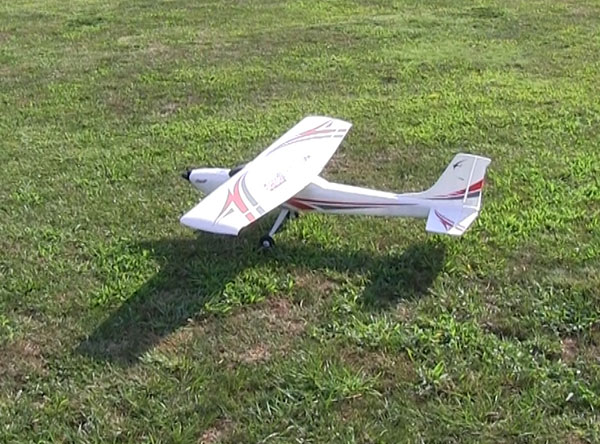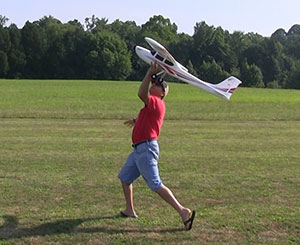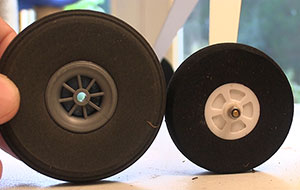



People keep trying to figure out how to mow grass so planes think it is pavement
but many planes can fly off of grass easily with a little "massaging".
Text, photos and video by Tom Hintz
Posted – 7-27-2016
One thing most RC clubs with a grass runway have in common is contention over the length of the grass. Small wheels want shorter grass no matter how short it is already. When I first returned to RC flying I flew electric planes exclusively and their typically undersized wheels made getting them off of the grass runway a little difficult. There were others in the club at the time who were arguing about the length of the grass. Rather than get involved in that “discussion” I put bigger wheels on and flew while they argued.
In recent years we have had a number of prospective pilots/members show up at our grass runway-equipped club with a plane that is obviously meant to fly off of pavement. Certainly the new prospective pilot can’t be expected to know that but there is a better than even chance that some person at a local hobby shop made the sale knowing full well that the local flying club has a grass, not paved runway.
What makes this frustrating is that the people selling these planes designed for hard surfaces to people they know are going to a grass runway quietly lay blame on the club for not catering to these planes with little wheels. Obviously there are planes out there that come equipped with larger, grass friendly wheels but depending on the hobby shop affiliation, some or all of those planes might not be available to them. So they continue to sell paved runway planes and let the local club take the heat for not having the paved runway those planes need.
Most RC clubs lease the property on which they fly and that agreement with the land owner makes installing a pavement runway a non-starter. Most club runways do not have irrigation nor could the club afford to buy the amount of water needed to keep overly short grass from burning out in virtually any climate that has a summer. I can’t think of anyone who flies RC aircraft that wouldn’t like to have a perfectly flat, smooth grass runway but most are aware that the infrastructure necessary to maintain such a tightly prepared surface is well beyond their financial capabilities. Another factor is the amount of work needed to maintain such a runway can be all but impossible to perform when less than 10% of the membership actually shows up for work days at the field.
For smaller planes hand launching might
seem like a good idea but it can be
dangerous for the plane and the launcher.
Many of the larger electric planes can be fitted with some of the modern lightweight wheels that let you increase their size with a minimal (if any) weight penalty. The combination of larger wheels and a little instruction on coaxing a small plane up out of the grass can help get some of the larger hard surface planes airborne and save the day for a new pilot who was about to trash a plane trying to fly it off of grass anyway.
Unfortunately, many of the smaller electric planes on the market today simply do not have enough power to take off from grass regardless how short it might be. The instructions that come with these planes often specify flying them off of a paved surface or hand launching them. While hand launching is a common way of getting smaller planes into the air it can be dangerous to the plane and bystanders if the person doing the launching and the person flying the plane are not familiar with this technique. If the plane has yet to be trimmed out by an experienced pilot the level of danger for the plane and spectators goes up a bunch.
Many trainer type airplanes use a tricycle landing gear with a steerable nose wheel. When these planes accelerate for takeoff on a grass runway the nose wheel tends to tuck under in response to the resistance of the grass. When the nose wheel tucks under the front of the plane is lowered changing the aerodynamic forces to where they are holding the plane down, not lifting it up. To get such a plane in the air excessive elevator is needed to get the angle of attack to where the plane will fly. Of course when the plane finally does break free of the ground it is going to want to nose up sharply if the pilot is not expecting it and a crash can be the next thing that happens.
Changing out just the nose wheel for a larger size can change the attitude of the plane enough to let the wing start making lift earlier so the plane flies out of the grass sooner without going into a stall when it does break free. I hear people say that the plane doesn’t look right with the bigger nose wheel and they have a point if scale appearance is the goal. If you want to fly a plane intended for paved runways off of a grass the larger nose wheel or larger wheels all the way around looks just fine.

Using larger wheels is possible on many
planes and does wonders for how it
handles grass runways.
Another way to make flying off a grass runway more enjoyable is to start with a larger plane that is better equipped for that type of runway. I have never had a “student” pilot that actually believed me when I told them that larger planes fly more easily and none that were not pleasantly surprised when they actually did fly a bigger plane. We aren’t talking jumping to giant scale, just a larger plane that comes with larger wheels that are more compatible with grass runways.
Larger planes also have more power that when combined with their larger lift-making wings and overall mass makes them better able to deal with more wind than smaller planes. That means in addition to being able to fly off of grass, you can fly on more days because wind is less of a deterrent. Spend a little time with an experienced pilot to learn some basic techniques for flying in higher winds and your potential flying days goes up again.
There is a solution to head off the all-to-common runway surface bickering – talk to the club BEFORE buying your first plane. Talk to the people who are at the field flying and likely to be training you to find out what planes they have had success with in the past and what they know to work on the runway they have available. These people have a vested interest in you learning to fly and enjoying it enough to join their club, not just make a sale as is too often the case these days. It is far easier to buy a compatible plane in the first place than it is to coerce the club into changing their runway to fit your plane.
Many years ago when I ran a huge and growing RC division of a large hobby shop the first question we asked of people wanting to buy a plane was where they were going to fly it. That told us what type of plane they needed to best fit the club field where they would be learning to fly. It is a little scary that so many of today’s retailers work harder to sell what they have on the shelf than to stock what their customers can succeed with.
It is important to know that not all hobby shops are the same. There are many shops where you can find a much wider range of planes for sale and people who can offer legitimate help in selecting your plane and where to fly it. Asking a couple quiet questions at the prospective flying field can often get you pointed to the right retailer.
Learning to fly RC planes is supposed to be fun. With the help of a plane compatible with the flying field and a qualified instructor you can be happily flying on your own and thinking about your next plane in short order. Or you can be practicing piecing a bargain plane back together with a high probability that its shortcomings will cause it to crash again.
Over the years I have taught a bunch of people to fly and loved every minute of it. I still help people fly when I can and do a fair amount of “trim flights,” getting someone’s new plane flying right so they can enjoy flying it themselves. All of this is way more fun when the new pilot shows up with a plane that fits the field. That is not a difficult thing to do if you ask the right people.
Apprentice S 15e vs. Sensei Trainer Match Up - Apprentice® S 15e VS. Sensei FS Stabilization Systems
Have a comment on this story? –Email Me!